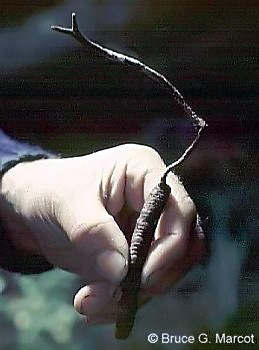 |
|
Vegetable Caterpillar |
|
|
Click on the image for a larger version
 |
|
Vegetable Caterpillar |
|
Vegetable Caterpillar -- Cordyceps sp., possibly C. robertsii, Ulva Island, off of Stewart Island, south New Zealand |
Credit & Copyright: Dr. Bruce G. Marcot
| Explanation: What in the
world is this? This might be one of the most bizzare species
relationships on the planet.
You are looking at a caterpillar that has been literally eaten from the inside out by a parasitic fungus called a "vegetable caterpillar." We are on tiny, remote Ulva Island, which is a boat ride from Stewart Island, which itself is south of South Island, New Zealand. In these remote southern forests -- remnants of ancient Gondwana forests -- lurks the vegetable caterpillar ... There are some 200 species of this fungus (Cordyceps) worldwide, and about 12 species on New Zealand alone. The fungus invades the living body of a moth pupa while the pupa is in its ground burrow, eating it from the inside out by secreting digestive juices into its mycelial threads that grow within the pupa's body and dissolve the internal organs. Like some creature from a sci-fi movie, the fungus assumes the pupa's shape and form by filling the pupa's body cavity with a dense mass of white mycelia known as a sclerotium. Eventually, the fungus puts out a fruiting body or stroma, shown above growing from the end of the doomed pupa. Stroma grow 30-40 cm long and eventually protrude through the burrow above ground. The end of the stroma contains perithecia that release spores that are probably wind-borne and disperse to infest more prey by being eaten nocturnally, or being inhaled through respiration. The Chinese prize vegetable caterpillars (especially the Asian species Cordyceps sinensis) for their medicinal use. The pre-European Maori on New Zealand called them awheto and used them as a tatooing pigment. Vegetable caterpillars are becoming increasingly confined to remote stands of relatively old and undisturbed forest, which provide habitat for the host moths. This might be one of the most bizarre "indicator species" of old-growth forests. Information source: Relph, David. 1991. Caterpillar-killer. New Zealand Geographic (Oct-Dec):114-119. |
Next week's picture: Palm on Stilts
Member Theme of Taos-Telecommunity